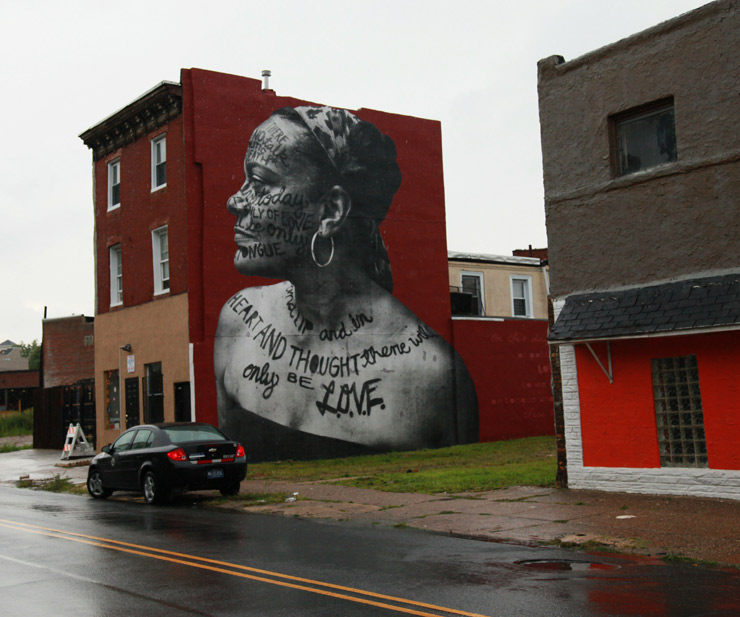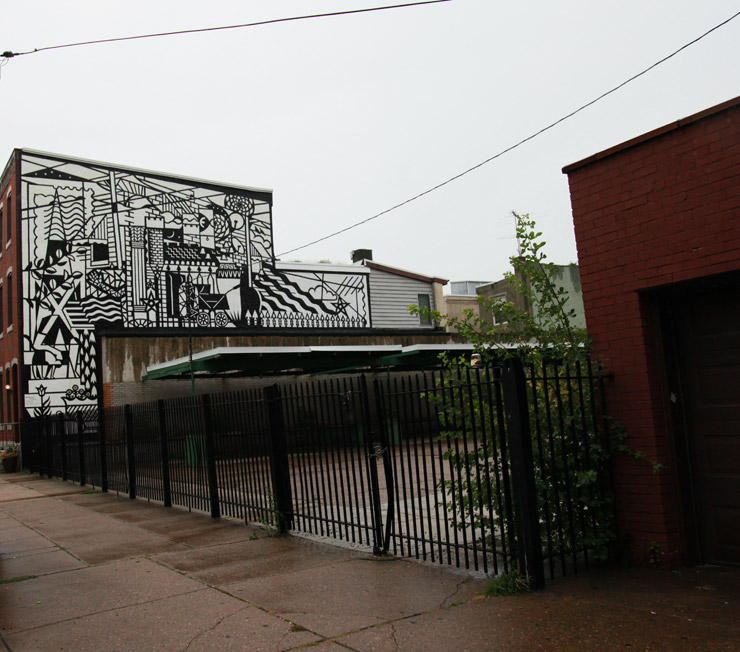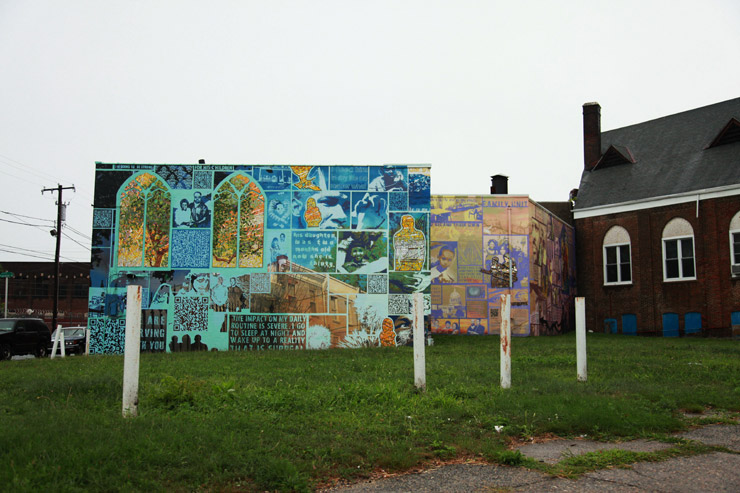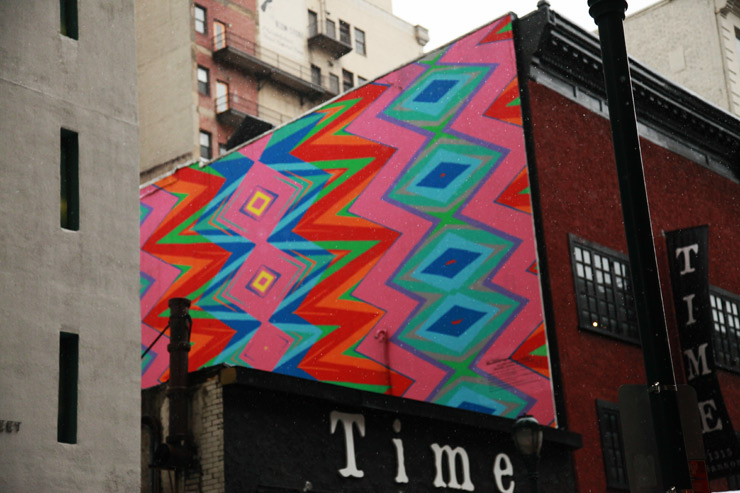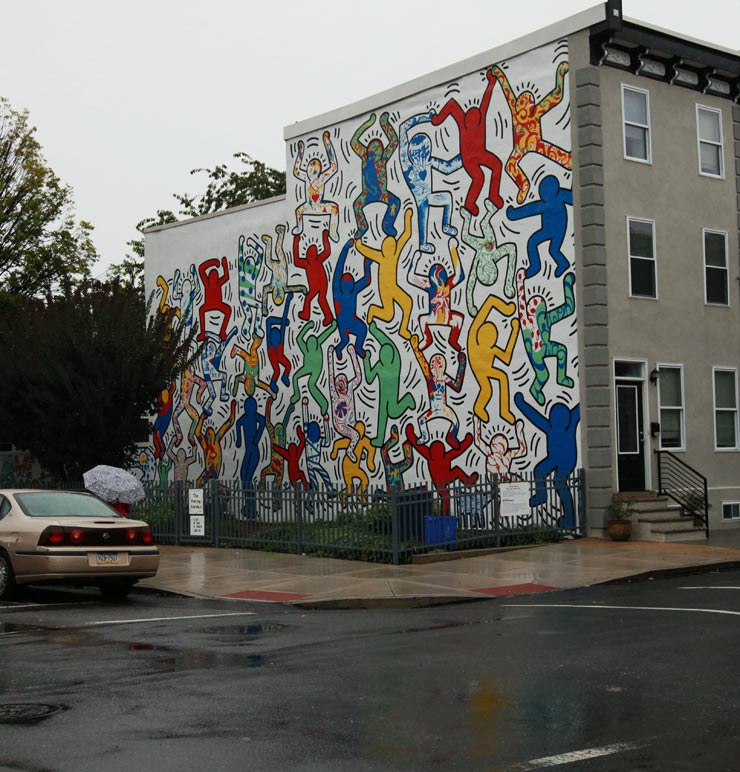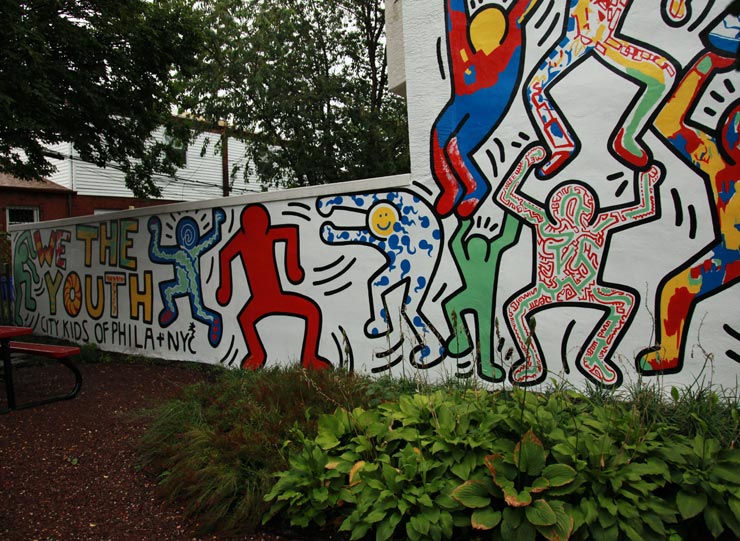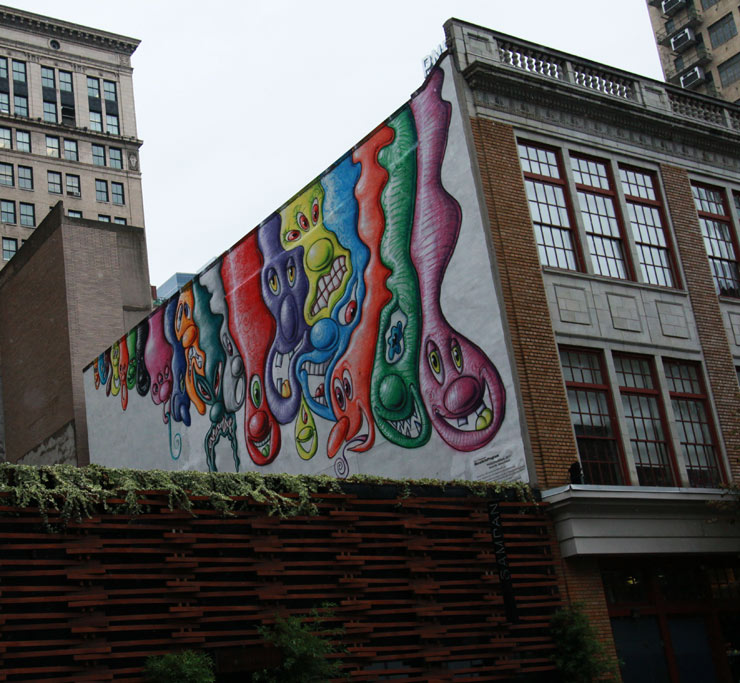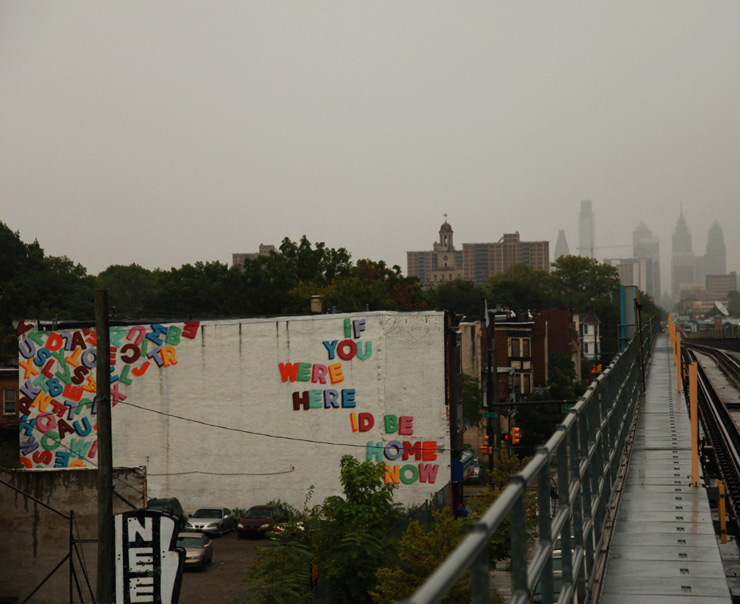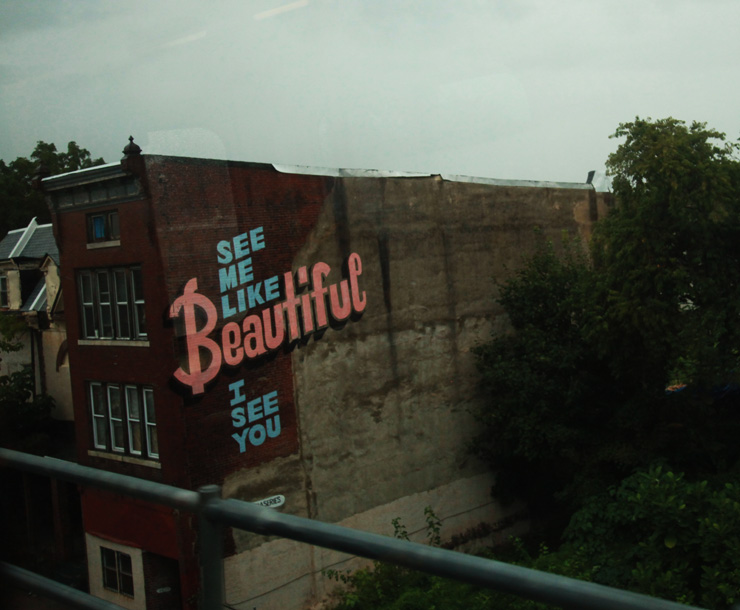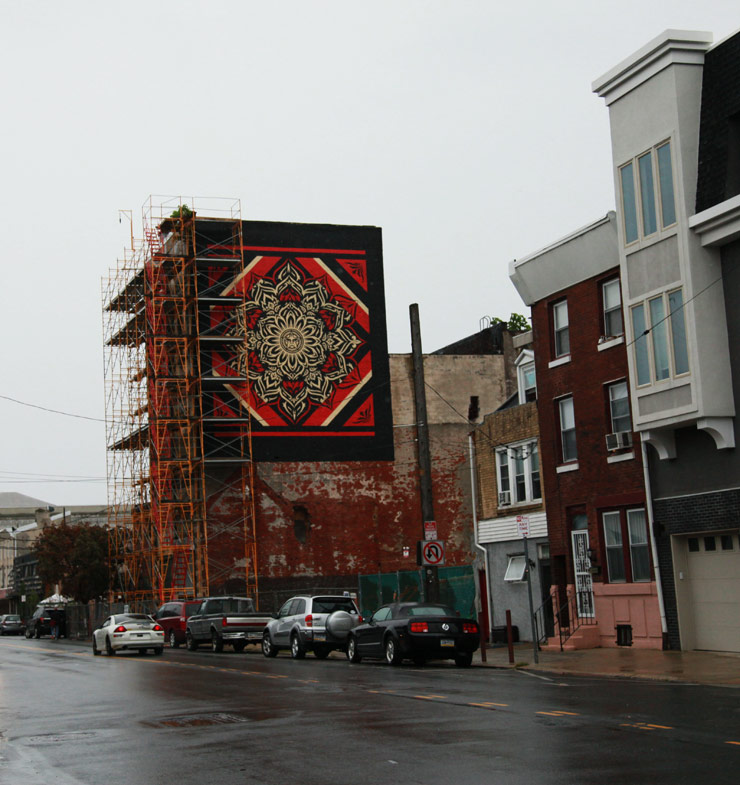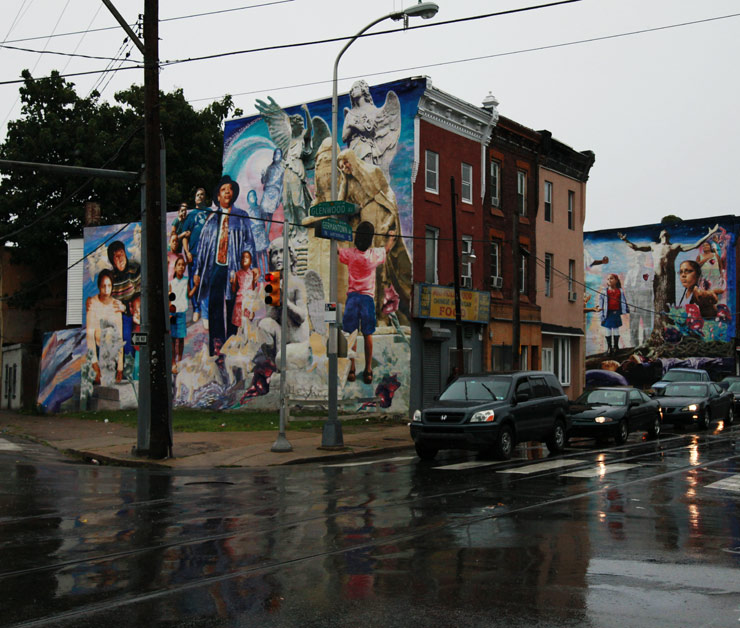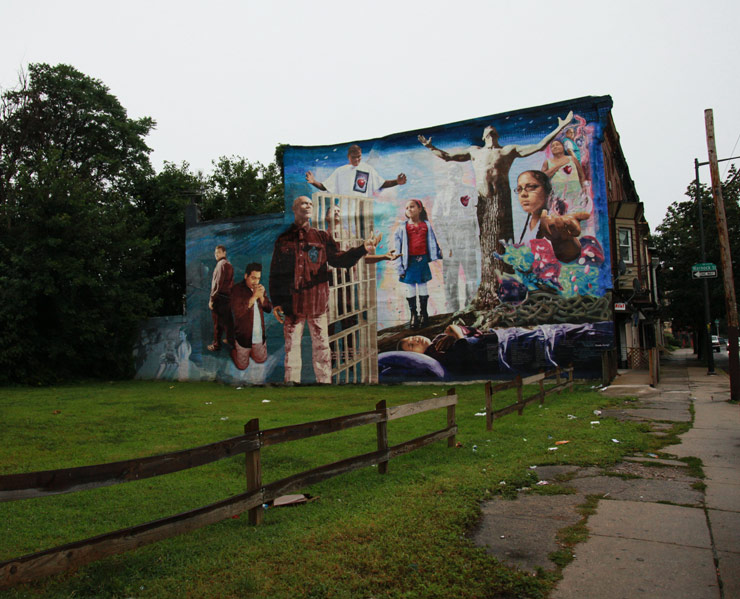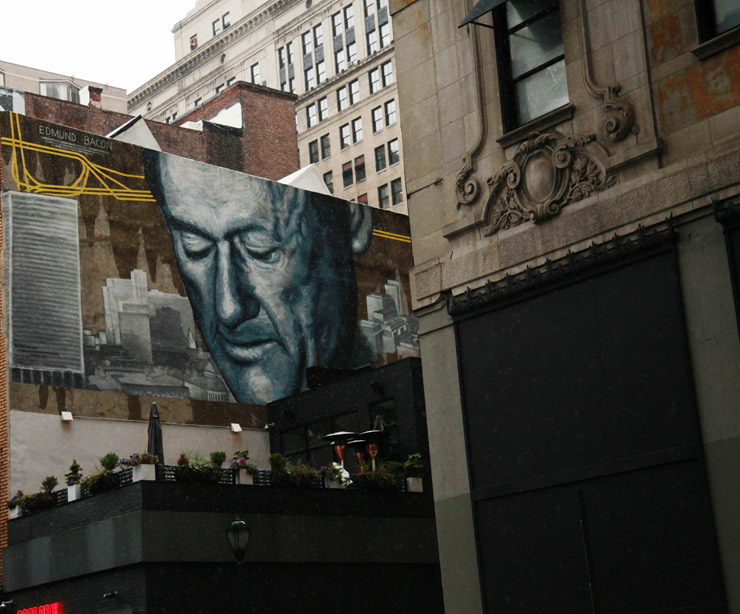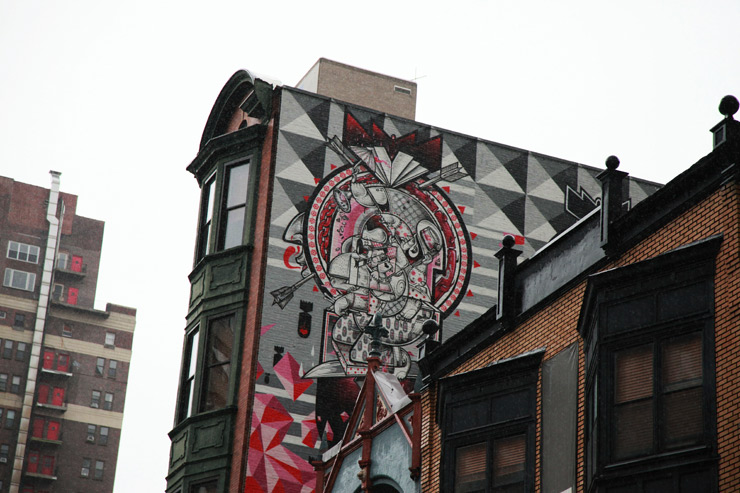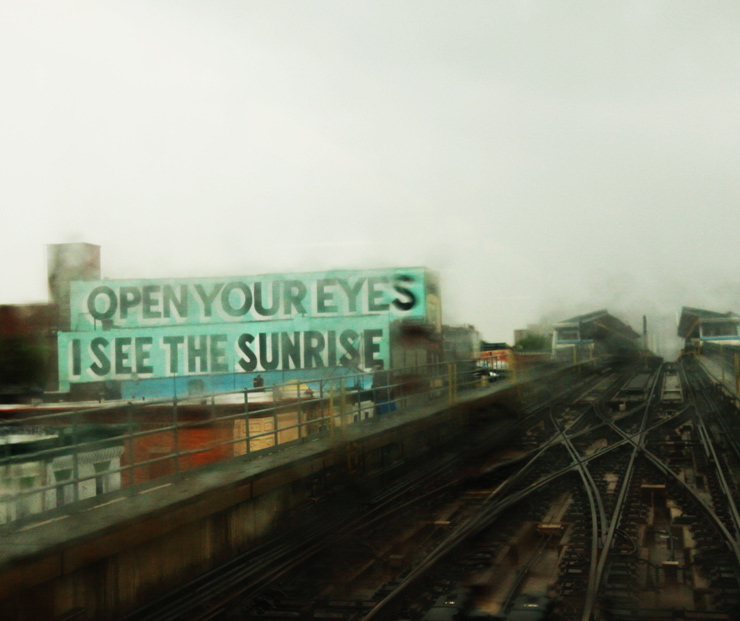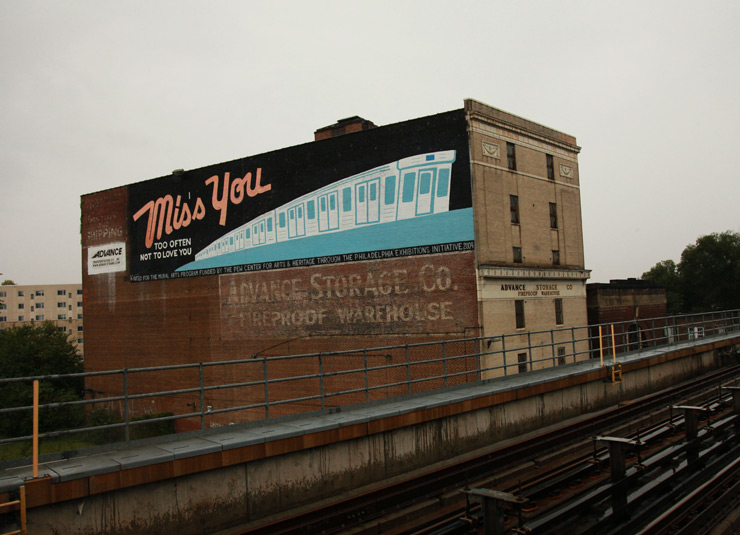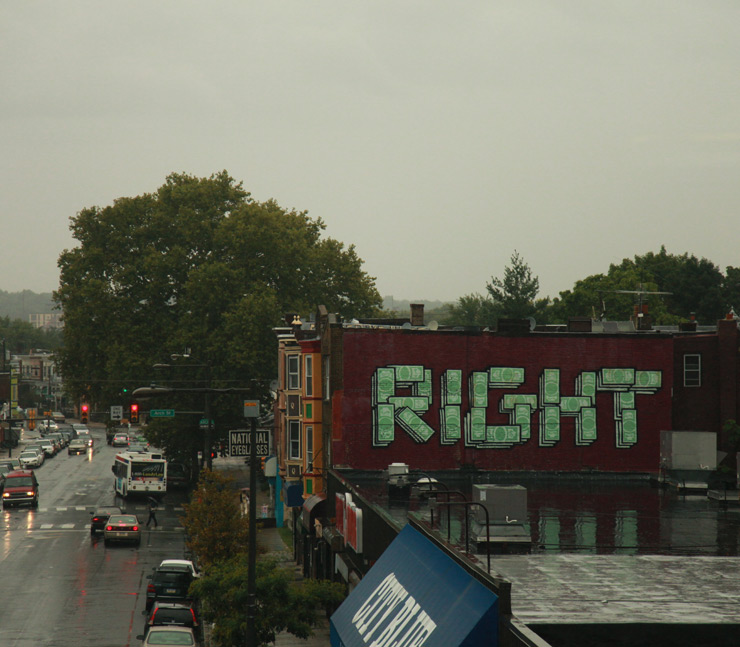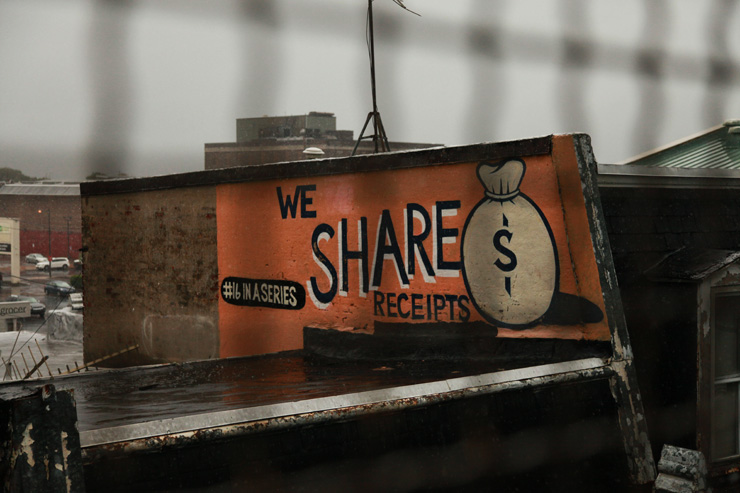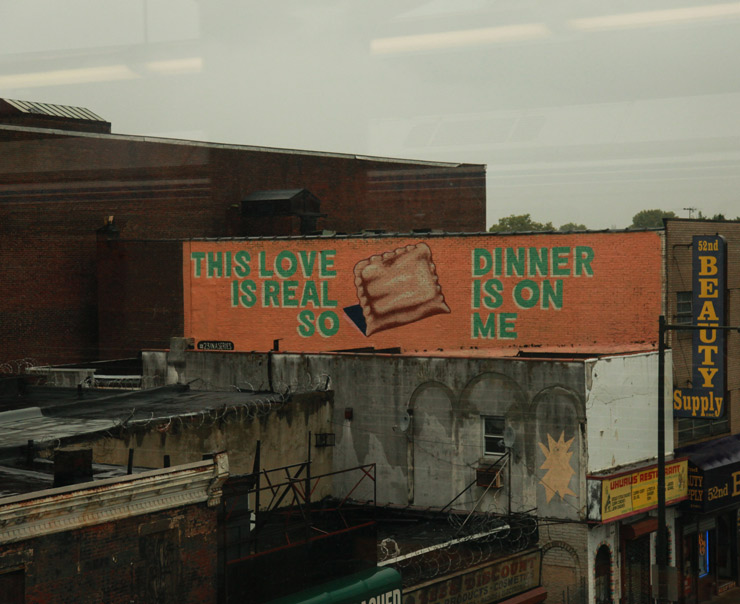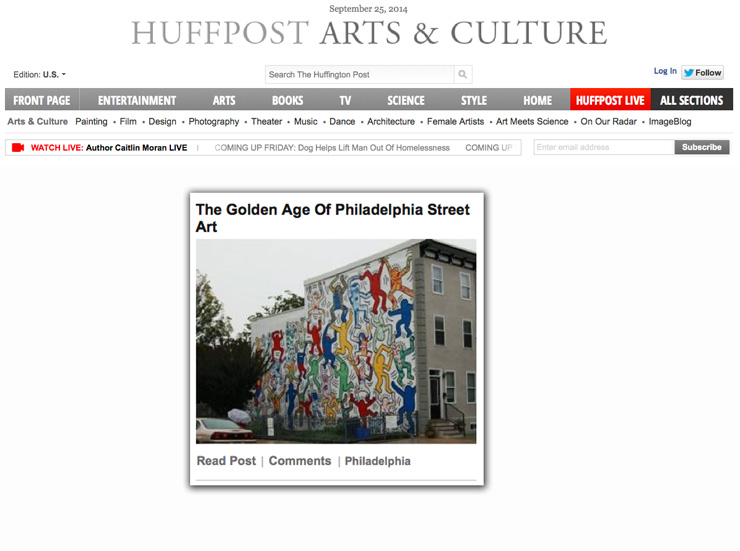It is a rainy day in Philadelphia, but you can’t tell it by listening to Jane Golden.
After 30 years and countless meetings with community groups, artists, city agencies, elected officials, volunteers, and donors, the founder and Executive Director of the Philadelphia Mural Arts Program has developed a perpetual advocacy style that leans decidedly toward axioms that tell you the glass is half full. No painting is happening on walls in the city of brotherly love today, but the phones are still ringing in this agency of 50, and as Golden sees it, the community is still being served by their educational programs and a remarkably wide variety of outreach efforts.
Jetsonorama and Ursula Rucker “You Go Girl” Mural Arts Program. Philadelphia, PA (photo © Jaime Rojo)
Street Art and graffiti have been parlaying with their cousin, the community mural, in recent years thanks to the growing popularity worldwide of the former so we thought this would be a great opportunity to learn about the largest and most successful version of the latter. What we found was that we share an underlying philosophy toward and an awe of the creative spirit, however it is expressed. In 2011 BSA curated a gallery show in LA with 39 artists called “Street Art Saved My Life” after hearing enough artists and graffiti writers express a similar sentiment over the previous 10 years or so. So it should not have been a revelation to find that Jane Golden is known to repeat an analogous mantra that summarizes her work here in Philadelphia: “Art Saves Lives”.
Initiated as an anti-graffiti campaign by the city in 1984, the program originally made the common mistake of equating a style of art-making with illegally made works. With time, education, and outreach to the graffiti-writing youth she met in the streets, Golden gradually helped the city to begin to make a distinction between aerosol art and vandalism. As graffiti writers and others were invited to participate in the mural program, interact with the community, and to get paid for their work, the city witnessed a slow and gradual metamorphosis to becoming a capital of public art revered by many.
Joe Boruchow “Watchtowers” Mural Arts Program. Philadelphia, PA (photo © Jaime Rojo)
A trained artist and political science scholar, Golden never embraced the so-called “Broken Window Theory” that typecasts people as it pertained to graffiti writers and instead she shepherded that creative instinct among artistic types whom she met into creating work that gives back.
“I think that it is almost the opposite of the “broken window” stereotype,” she says, “This is about opportunity and possibility. It is opening up a window that wasn’t previously open in a way that people hadn’t anticipated.” She talks about the impact the Mural Arts Program has with its tireless outreach to engage neighborhoods in the decision making process about what work goes where, and she guarantees you that the overall effect is greater than a pretty picture.
Eric Okdeh “Family Interrupted”” Mural Arts Program. Philadelphia, PA (photo © Jaime Rojo)
“I have seen it in communities where there was support for the project, but maybe not universal support. Then the mural goes up and suddenly there’s this ripple effect. When people start talking about it, connecting with it, thinking about other things and then sometimes thinking about things that are totally unrelated to us but if you were to do a diagram of the various outcomes, you know that it started with us.”
One example is a mural in the late 1980s that enlivened a neighborhood and inspired a community group to form and eventually become a powerful force of advocacy for the needs of neighbors. “When we did this “peace” mural the neighborhood reclaimed the space and then they bought a house from the city for a dollar and turned it into a headquarters. Then they lobbied for more art, then they lobbied for educational programs,” she says as she describes the evolution of a community that may have once felt like prey to a vocal one that now comes to speak to her students a the University of Pennsylvania about topics like economic development.
Christophe Hamaide-Pierson of Assume Vivid Astro Focus “All Very Amazing Fingers” Mural Arts Program in collaboration with Goldman Properties. Philadelphia, PA (photo © Jaime Rojo)
“I’m not saying that what we do is a panacea for all that ails the city but the catalytic role that art plays can’t be discounted because it is igniting something in us; it’s transformative. Art engages people in a way that just doesn’t happen in their day-to-day life. We want to help change the city and we feel that art is part of it.”
A particular threshold sighted for Street Art into the mural arts program was when artist Keith Haring painted “We the Youth” here in 1987, and that mural became part of the city in such a strong way that Mural Arts undertook a painstaking restoration of it a few years ago, as it has with many murals. It wasn’t unusual in those early years of the program for murals to be done without proper consideration for life of the paint or the surface it was on.
Keith Haring “We The Youth” Mural Arts Program. Philadelphia, PA (photo © Jaime Rojo)
“With the Keith Haring mural the stucco was in such a bad shape we had to almost re-do the entire surface and that was an extensive process of peeling layers off. We wanted to make sure as we were restoring it we were remaining true to the original that Keith painted and it had to be done with incredible care, love and integrity. So we took its restoration and preservation really seriously and because it was necessary to do it right, we re-routed some funding from new projects to restoration.”
Keith Haring “We The Youth” Mural Arts Program. Philadelphia, PA (photo © Jaime Rojo)
Procuring funding for the many Mural Arts programs is an original model that other public arts programs have looked at – a balance of public and private that has enabled it to grow and support artists as well as the city itself – a system of securing funding that Golden describes as sort of an art in itself. “We are a city agency and we have gotten to a point where our budget is 35 % city and the rest is non-city funding through foundations, corporation and individuals earned income. It is an interesting hybrid model but that city part still resonates.”
She describes the alchemy of going to private donors as well as testifying about her budget before the city periodically. “We formed a board, we got our own 501c 3, and I just went underground,” as she describes the additional funding that enables multiple programs and actually pays artists a fair price for their work – something that the majority of Street Art festivals and various real estate holders are very reluctant to do – to the tune of nearly $2.2 million a year.
Kenny Scharf. Mural Arts Program in collaboration with Goldman Properties. Philadelphia, PA. (photo © Jaime Rojo)
“Someone told me about this art festival recently and said that they are paying the artists 300-500 dollars to do a major work and I said ‘What?’” she says incredulously, and scoffs at the idea that artists would work simply for “exposure”. “We pay our interns! We pay our middle school students in the summer. Seriously? Everybody here is getting paid.” Granted, it isn’t always as much as they would like to pay an artist, but she makes sure the artists understand the full scope of the project before asking them to commit.
Despite the negative association many still have with graffiti and Street Artists a fair number have been joining in with the Mural Arts Program in recent years. With known and respected Street Art blogger RJ Rushmore joining the enterprise as Communications Manager two months ago, you can expect to see perhaps a few more names from the Street Art scene on the walls as time goes forward.
Steve ESPO Powers “Love Letter” Mural Arts Program. Philadelphia, PA (photo © Jaime Rojo)
“The Street Artists are inspired by Mural Arts and we are inspired by them,” says Golden, who is enthusiastic about this subtle programming shift that she began a few years ago with the encouragement of people like real estate developer Tony Goldman, who was credited with transforming neighborhoods like Manhattan’s Soho and Miami’s Wynwood District, and whose company acquired 25 properties from 1998 through 2003 in Philadelphia, according to the Goldman website.
“When (graffiti and Street Artist) Steven Powers contacted me to work together and he had this great idea, I said ‘I totally want to work with you’,” she says of his multi-building text project “Love Letters” that you can view from an elevated train line. There weren’t any rules that say I couldn’t – we just need to get funding.” Of course it was as simple as Powers may have originally thought because the neighborhood also needed to be consulted, a practice Golden will not waver from.
Steve ESPO Powers “Love Letter” Mural Arts Program. Philadelphia, PA (photo © Jaime Rojo)
“Steve couldn’t believe he had to go to community meetings and I said ‘but you have to’.” As it turned out, the neighborhood had no interest in love letters. “We don’t want to talk about love. We are actually really angry at the city because the mass transit agency has shot down one of the major thoroughfares for repair work'” she remembers.
Some also didn’t understand the idea of text-based artwork rather than representational or figurative work. “’This isn’t a Mural Arts mural’, some folks in the neighborhood remarked. And I said ‘There isn’t really such a thing as a Mural Arts mural – its about creativity and its impact on the world’ and people then interestingly enough started to open up. They started to talk to Steve about their past, about what they did love about their neighborhood, about their memories and history and stories. It was fantastic and so it was a different kind of process and it had power on its own. That was a clue to us that we had built up 20 years of goodwill and we can now take risks as long as we are respectful and that will never change. It paid off because it opened the door for us to think differently about how we work.”
Shepard Fairey “Lotus Diamond” Mural Arts Program. Philadelphia, PA (photo © Jaime Rojo)
She speaks as well about some of the other Street Artists from recent years. “Then we had Shepard (Fairey), and Chris Stain and How & Nosm,” she recalls. “I think their art is terrific and when they are here I want them to be a role model for the kids. Like How & Nosm – they were role models. They couldn’t have been nicer, kinder to our kids. Here are guys who started writing graffiti on walls and now they are traveling the world with their art and that is a fantastic message. For our kids to know that Shepard started out as a student at the Rhode Island School of Design, that he was doing stickers, and that now he’s got a big design firm, it was important. We do have an entrepreneurial division at Mural Arts and Shepard is a role model for them.”
Sometimes the value of the project is not simply monetary but goes far deeper, which explains the level of commitment many have shown. We asked Golden to describe a couple of projects that have been personally satisfying for her, and we share one here that illustrates the entirely holistic approach Golden and the Mural Arts program take to art in the streets.
Cesar Viveros and Parris Stancell “Healing Walls” Mural Arts Program. Philadelphia, PA (photo © Jaime Rojo)
She describes what evolutionary process contributed to the creation of a series of “healing walls” that depict all the members of community who are affected by crime; the criminal, the victim, and all the people they touch. Of the many outstanding aspects of the project, one is that the people who are involved, including the offender, are deeply involved in its creation.
“We did a project with crime victims, victim’s advocates and prisoners in our mural class. We decided to start work in the prison. The men in the class said they wanted to do outdoor murals. I said ‘you are lifers, you are never getting out, how in the world are you going to do that?’” she says as she describes a solution that enabled the artwork of the prisoners to be mounted on the mural walls. “We work a lot on parachute cloth, so we thought we could do this, we can work inside and take it outside.”
Cesar Viveros and Parris Stancell “Healing Walls” Mural Arts Program. Philadelphia, PA (photo © Jaime Rojo)
The rallying together of the participants was not always smooth as the project began, she says, as the raw emotions and torn lives at times overwhelmed the process of creating the mural and voices of discontent threatened to capsize the project. “So I went to the Pennsylvania Prison Society, and I did research and designed a project called “Healing Walls” and I said ‘We are going to bring together everyone to talk about the impact and consequences of violent crime, because when crime happens everyone loses.”
In a process emblematic of the painstaking lengths Mural Arts goes to seek common ground, Golden describes where the main obstacle to the project lay. “So we asked everyone in this group from all different walks of life to come together to create a series of murals about this. We are going to work partially in the prison, we’ll work in a church in the neighborhood, we are going to work here at the Mural Arts offices and we are going to work in some schools. Then the project started and it was contentious,” she says.
“No one wanted to get along because everyone had their story;
‘My pain is bigger.’
‘I’m from the neighborhood and we are scarred.’
‘Our neighborhood has been victimized.’
And no one understands the pain of the victim; The victim said, ‘I lost everything.’ Then the prisoner said, ‘I have been in pain since I was young. I’m filled with remorse.’ ”
GAIA. Mural Arts Program in collaboration with Goldman Properties. Philadelphia, PA. (photo © Jaime Rojo)
After each party was heard and the project threatened to fall in disarray, an unexpected outcome began to emerge, says Golden.
“Then eventually, over time, we started to create together. We’re in a giant auditorium and we have tons of tables. On each table we have crime victims, victims advocates and prisoners. Then people started to say, ‘Can you pass the glue? Can you pass the brush? What about my shape? Then what happens was kind of miraculous because people began to listen to each other as they painted together. Eventually people were like ‘You know what? We really need to come together. We all want a safer city. What can we do about it and people started brainstorming – People behind the walls and people on the outside.”
“Then the murals went up and we had a dedication at this church and tons of people showed up. People’s whose sisters and brothers were incarcerated were there, victims were there, the Department of Corrections came and there was a major conversation about redemption and rehabilitation and giving people a chance. It sort of tapped into people’s humanity that no one had articulated.”
How & Nosm. Mural Arts Program in collaboration with Goldman Properties. Philadelphia, PA. (photo © Jaime Rojo)
Thirty years and a few thousand painted walls are only some of the outcomes of a program like this, but countless more are told in the generative effects, the rippling of waves of the efforts by artists and community. Those outcomes are impossible to measure or to quantify, even though we try.
BSA: It appears that you can use the art as a vehicle and you are a bit of an anthropologist, ethnologist, sociologist – so along with your formal education you are getting many degrees as you go in the process.
Jane Golden: I believe in what we are doing, that art making is really about access, justice and equity. That’s the real deal for us, a lot of it. But I love this merging of worlds but you are right in order to do this work it is anthropology, sociology, urban planning, urbanism its everything…
Steve ESPO Powers “Love Letter” Mural Arts Program. Philadelphia, PA (photo © Jaime Rojo)
“When people think of mural arts I want them to think: ‘They have a little budget, they do tons of work, they are relevant to my life and they are impactful,’” says Ms. Golden. “And that, I think, is important and that connects me to something else that I have seen especially over the last five, six, or seven years. That is that when it comes to solving societies’ more intractable problems – we can never discount the role of innovation and creativity to make a difference when our traditional interventions have failed us.”
And then we go out and ride the train and look at more murals in the rain.
Steve ESPO Powers “Love Letter” Mural Arts Program. Philadelphia, PA (photo © Jaime Rojo)
Steve ESPO Powers “Love Letter” Mural Arts Program. Philadelphia, PA (photo © Jaime Rojo)
Steve ESPO Powers “Love Letter” Mural Arts Program. Philadelphia, PA (photo © Jaime Rojo)
Steve ESPO Powers “Love Letter” Mural Arts Program. Philadelphia, PA (photo © Jaime Rojo)
To learn more about the Philadelphia Mural Arts Program click HERE
BSA would like to thank Ms. Jane Golden for her generous time with us and also Mr. Brian Campbell and RJ Rushmore for their gracious hospitality, guided tour of the murals and lunch.
<<>>><><<>BSA<<>>><<<>><><BSA<<>>><><<>BSA<<>>><<<>><><BSA
Please note: All content including images and text are © BrooklynStreetArt.com, unless otherwise noted. We like sharing BSA content for non-commercial purposes as long as you credit the photographer(s) and BSA, include a link to the original article URL and do not remove the photographer’s name from the .jpg file. Otherwise, please refrain from re-posting. Thanks!
<<>>><><<>BSA<<>>><<<>><><BSA<<>>><><<>BSA<<>>><<<>><><BSA
This article was also published on The Huffington Post
Other Articles You May Like from BSA:
Urban artist and urbanist Jens Besser from Dresden, Germany paints the city into his city. An organizer of mural programs and avid bicyclist throughout this historic Saxony capital of a half million,...
Our weekly focus on the moving image and art in the streets. And other oddities. Now screening : 1. The Haus - Lunatix Dance 2. Mobilize Walls (Against the Trump Wall) 3. The Yok & Sheryo: T...
Merry Christmas from BSA!! On Christmas we send our very best wishes to you and your family and loved ones. Happy Hanukkah to you as well! Happy Kwanzaa! Happy Solstice! No matter your rel...
Spidertag. INM#16 in collaboration with Justkids and Oz Art NWA. Bentonville, Arkansas. (photo © Justkids) Bentonville, Arkansas is more known for Crystal Bridges Museum of American Art, The Mome...
Our weekly focus on the moving image and art in the streets. And other oddities. Now screening : 1. Swoon and Submerged Motherlands 2. Nuart PLUS features BSA FILM FRIDAY LIVE 3. Joh...
 BROOKLYN STREET ART LOVES YOU MORE EVERY DAY
BROOKLYN STREET ART LOVES YOU MORE EVERY DAY